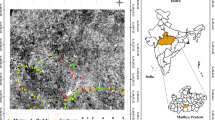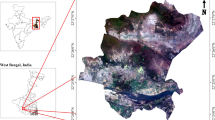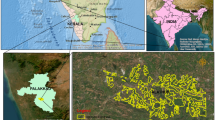Abstract
In the following study, an attempt is made for crop classification of rainy season through analyzing time-series Sentinel-1 SAR data of May 2020 to September 2020. The SVIDP index derived from dual-pol (VV and VH) bands consisting of NRPB (\({\sigma }^{0}{vh}_{ij}- {\sigma }^{0}{vv}_{ij}/{\sigma }^{0}{vh}_{ij}+ {\sigma }^{0}{vv}_{ij}\)), DPDD \({(\sigma }^{0}{vh}_{ij}+ {\sigma }^{0}{vv}_{ij})/ \surd 2\)), IDPDD (\({\sigma}^{0}{vv}_{(max)}- {\sigma }^{0}{vv}_{ij})+{\sigma }^{0}{vh}_{ij}/ \surd 2\)), and VDDPI \(({\sigma }^{0}{vh}_{ij}+{\sigma }^{0}{vv}_{ij}/ {\sigma }^{0}{vv}_{ij})\) ratios are utilized for discriminating inter-vegetative boundaries of crop pixels. This study was conducted near Karnal city region, Karnal district, Haryana, India. The Sentinel-1 data has the capability to penetrate thick cloud cover and provide high revisit frequency data for rain-fed crops. Obtained classification achieved higher accuracy in both RF (93.77%) and SVM (93.50%) classifiers. Obtained linear regression statistics of mean raster imagery reveals that IDPDD index is much sensitive to other crop which has highest standard deviations in σvh° and σvv° bands throughout the period, and high R2 with σvh° (0.70), VV (0.58), NRPB (0.693), and DPDD (0.697) indices. In contrast to this, IDPDD index has least correlation (< 0.289) with σvh°, σvv°, EVI 2, NRPB, and DPDD indices for water body which has smooth surface and lowest SAR backscattering with minimum standard deviations in the same period.









Similar content being viewed by others
References
Ackermann, N. (2014). Growing Stock Volume Estimation in Temperate Forested Areas Using a Fusion Approach with SAR Satellites Imagery. Springer.
Ali, I., Cao, S., Naeimi, V., Paulik, C., & Wagner, W. (2018). Methods to remove the border noise from Sentinel-1 synthetic aperture radar data: Implications and importance for time-series analysis. IEEE Journal of Selected Topics in Applied Earth Observations and Remote Sensing, 11(3), 777–786.
Arias Cuenca, M., Campo-Bescós, M., & Álvarez-Mozos, J. (2020). Crop classification based on temporal signatures of Sentinel-1 observations over Navarre province, Spain. Remote Sensing, 12(2), 278.
Bargiel, D. (2017). A new method for crop classification combining time series of radar images and crop phenology information. Remote Sensing of Environment, 198, 369–383.
Boken, S. L., Staples, C. R., Sollenberger, L. E., Jenkins, T. C., & Thatcher, W. W. (2005). Effect of grazing and fat supplementation on production and reproduction of Holstein cows. Journal of Dairy Science, 88(12), 4258–4272.
Bousbih, S., Zribi, M., Lili-Chabaane, Z., Baghdadi, N., El Hajj, M., Gao, Q., & Mougenot, B. (2017). Potential of Sentinel-1 radar data for the assessment of soil and cereal cover parameters. Sensors, 17(11), 2617.
Zhang, R., Sathishkumar, V. E., & Samuel, R. D. (2020). Fuzzy efficient energy smart home management system for renewable energy resources. Sustainability, 12(8), 3115. https://doi.org/10.3390/su12083115
Breiman, L. (1996). Bagging predictors. Machine learning, 24(2), 123–140.
Choudhury, B. J., & Tucker, C. J. (1987). Monitoring global vegetation using Nimbus-7 37 GHz Data Some empirical relations. International Journal of Remote Sensing, 8(7), 1085–1090.
Colwell, J. E. (1974). Vegetation canopy reflectance. Remote Sensing of Environment, 3(3), 175–183.
Das, K., & Paul, P. K. (2015). Present status of soil moisture estimation by microwave remote sensing. Cogent Geoscience, 1(1), 1084669.
Dash, J., & Curran, P. J. (2004). The MERIS terrestrial chlorophyll index. International Journal of Remote Sensing, 25, 5403–5413.
Dobson, M. C., Ulaby, F. T., Hallikainen, M. T., & El-Rayes, M. A. (1985). Microwave dielectric behavior of wet soil-Part II: Dielectric mixing models. IEEE Transactions on Geoscience and Remote Sensing, 1, 35–46.
Dubois, P. C., Van Zyl, J., & Engman, T. (1995). Measuring soil moisture with imaging radars. IEEE Transactions on Geoscience and Remote Sensing, 33(4), 915–926.
Engman, E. T., & Chauhan, N. (1995). Status of microwave soil moisture measurements with remote sensing. Remote Sensing of Environment, 51(1), 189–198.
Weissel, J. K., Czuchlewski, K. R., & Kim, Y. (2004). Synthetic aperture radar (SAR)-based map** of volcanic flows: Manam Island, Papua New Guinea. Natural Hazards and Earth System Sciences, 4(2), 339–346.
Filipponi, F. (2019). Sentinel-1 GRD preprocessing workflow. Multidisciplinary Digital Publishing Institute Proceedings, 18(1), 11.
Filgueiras, R., Mantovani, E. C., Althoff, D., Fernandes Filho, E. I., & Cunha, F. F. D. (2019). Crop NDVI monitoring based on sentinel 1. Remote Sensing, 11(12), 1–21.
Freeman, A. (1993). Radiometric calibration of SAR image data. International Archives of Photogrammetry and Remote Sensing, 29, 212–212.
Huang, C., Davis, L. S., & Townshend, J. R. G. (2002). An assessment of support vector machines for land cover classification. International Journal of Remote Sensing, 23(4), 725–749.
Jackson, T. J., Le Vine, D. M., Hsu, A. Y., Oldak, A., Starks, P. J., Swift, C. T., & Haken, M. (1999). Soil moisture map** at regional scales using microwave radiometry: The Southern Great Plains Hydrology Experiment. IEEE Transactions on Geoscience and Remote Sensing, 37(5), 2136–2151.
Karjalainen, M., Kaartinen, H., & Hyyppä, J. (2008). Agricultural monitoring using Envisat alternating polarization SAR images. Photogrammetric Engineering & Remote Sensing, 74(1), 117–126.
Kussul, N., Lemoine, G., Gallego, F. J., Skakun, S. V., Lavreniuk, M., & Shelestov, A. Y. (2016). Parcel-based crop classification in ukraine using landsat-8 data and sentinel-1A data. IEEE Journal of Selected Topics in Applied Earth Observations and Remote Sensing, 9(6), 2500–2508.
Lee, J. S., Jurkevich, L., Dewaele, P., Wambacq, P., & Oosterlinck, A. (1994). Speckle filtering of synthetic aperture radar images: A review. Remote Sensing Reviews, 8(4), 313–340.
Leprieur, C., Verstraete, M. M., & Pinty, B. (1994). Evaluation of the performance of various vegetation indices to retrieve vegetation cover from AVHRR data. Remote Sensing Reviews, 10(4), 265–284.
Mandal, D., Kumar, V., Bhattacharya, A., Rao, Y. S., Siqueira, P., & Bera, S. (2018). Sen4Rice: A processing chain for differentiating early and late transplanted rice using time-series Sentinel-1 SAR data with Google Earth engine. IEEE Geoscience and Remote Sensing Letters, 15(12), 1947–1951.
Mandal, D., Kumar, V., Ratha, D., Dey, S., Bhattacharya, A., Lopez-Sanchez, J. M., & Rao, Y. S. (2020). Dual polarimetric radar vegetation index for crop growth monitoring using sentinel-1 SAR data. Remote Sensing of Environment, 247, 111954.
McNairn, H., & Shang, J. (2016). A review of multitemporal synthetic aperture radar (SAR) for crop monitoring. Multitemporal Remote Sensing (pp. 317–340). Cham: Springer.
Narvekar, P. S., Entekhabi, D., Kim, S. B., & Njoku, E. G. (2015). Soil moisture retrieval using L-band radar observations. IEEE Transactions on Geoscience and Remote Sensing, 53(6), 3492–3506.
Nguyen, D. B., Gruber, A., & Wagner, W. (2016). Map** rice extent and crop** scheme in the Mekong Delta using Sentinel-1A data. Remote Sensing Letters, 7(12), 1209–1218.
Orjuela, K. G., Gaona-García, P. A., & Marin, C. E. (2020). Towards an agriculture solution for product supply chain using blockchain: Case study Agro-chain with BigchainDB. Acta Agriculturae Scandinavica, Section B - Soil & Plant Science, 71(1), 1–16. https://doi.org/10.1080/09064710.2020.1840618
Paloscia, S., & Pampaloni, P. (1988). Microwave polarization index for monitoring vegetation growth. IEEE Transactions on Geoscience and Remote Sensing, 26(5), 617–621.
Park, J. W., Korosov, A., & Babiker, M. (2017). Efficient thermal noise removal of Sentinel-1 image and its impacts on sea ice applications (p. 12613). EGUGA.
Periasamy, S. (2018). Significance of dual polarimetric synthetic aperture radar in biomass retrieval: An attempt on Sentinel-1. Remote Sensing of Environment, 217, 537–549.
Rao, S. S., Das, S. N., Nagaraju, M. S. S., Venugopal, M. V., Rajankar, P., Laghate, P., & Sharma, J. R. (2013). Modified Dubois model for estimating soil moisture with dual polarized SAR data. Journal of the Indian Society of Remote Sensing, 41(4), 865–872.
Santoso, A. W., Bayuaji, L., Pebrianti, D., Awang, S., Sze, L. T., Lateh, H., & Zain, J. M. (2016). A fuzzy approach for speckle noise reduction in SAR images. International Journal of Advanced and Applied Sciences, 3(5), 33–38.
Schmidt, K., Schwerdt, M., Miranda, N., & Reimann, J. (2020). Radiometric comparison within the Sentinel-1 SAR constellation over a wide backscatter range. Remote Sensing, 12(5), 854.
Sellers, P. J. (1985). Canopy reflectance, photosynthesis and transpiration. International Journal of Remote Sensing, 6(8), 1335–1372.
Song, K., Zhou, X., & Fan, Y. (2010). Retrieval of soil moisture content from microwave backscattering using a modified IEM model. Progress in Electromagnetics Research, 26, 383–399.
Whelen, T., & Siqueira, P. (2018). Time-series classification of Sentinel-1 agricultural data over North Dakota. Remote Sensing Letters, 9(5), 411–420.
Topp, G. C., Davis, J. L., & Annan, A. P. (1980). Electromagnetic determination of soil water content: Measurements in coaxial transmission lines. Water Resources Research, 16(3), 574–582.
Ulaby, F. T., Dubois, P. C., & Van Zyl, J. (1996). Radar map** of surface soil moisture. Journal of Hydrology, 184(1–2), 57–84.
Ulaby, F. (1975). Radar response to vegetation. IEEE Transactions on Antennas and Propagation, 23(1), 36–45.
Valenzuela, G. R. (1978). Theories for the interaction of electromagnetic and oceanic waves–A review. Boundary-Layer Meteorology, 13(1–4), 61–85.
Van Tricht, K., Gobin, A., Gilliams, S., & Piccard, I. (2018). Synergistic use of radar Sentinel-1 and optical Sentinel-2 imagery for crop map**: A case study for Belgium. Remote Sensing, 10(10), 1642.
Author information
Authors and Affiliations
Corresponding author
Ethics declarations
Conflict of interest
The authors declare no competing interests.
Additional information
Publisher's Note
Springer Nature remains neutral with regard to jurisdictional claims in published maps and institutional affiliations.
Appendix
Appendix
Rights and permissions
Springer Nature or its licensor (e.g. a society or other partner) holds exclusive rights to this article under a publishing agreement with the author(s) or other rightsholder(s); author self-archiving of the accepted manuscript version of this article is solely governed by the terms of such publishing agreement and applicable law.
About this article
Cite this article
Mishra, D., Pathak, G., Singh, B.P. et al. Crop classification by using dual-pol SAR vegetation indices derived from Sentinel-1 SAR-C data. Environ Monit Assess 195, 115 (2023). https://doi.org/10.1007/s10661-022-10591-x
Received:
Accepted:
Published:
DOI: https://doi.org/10.1007/s10661-022-10591-x




